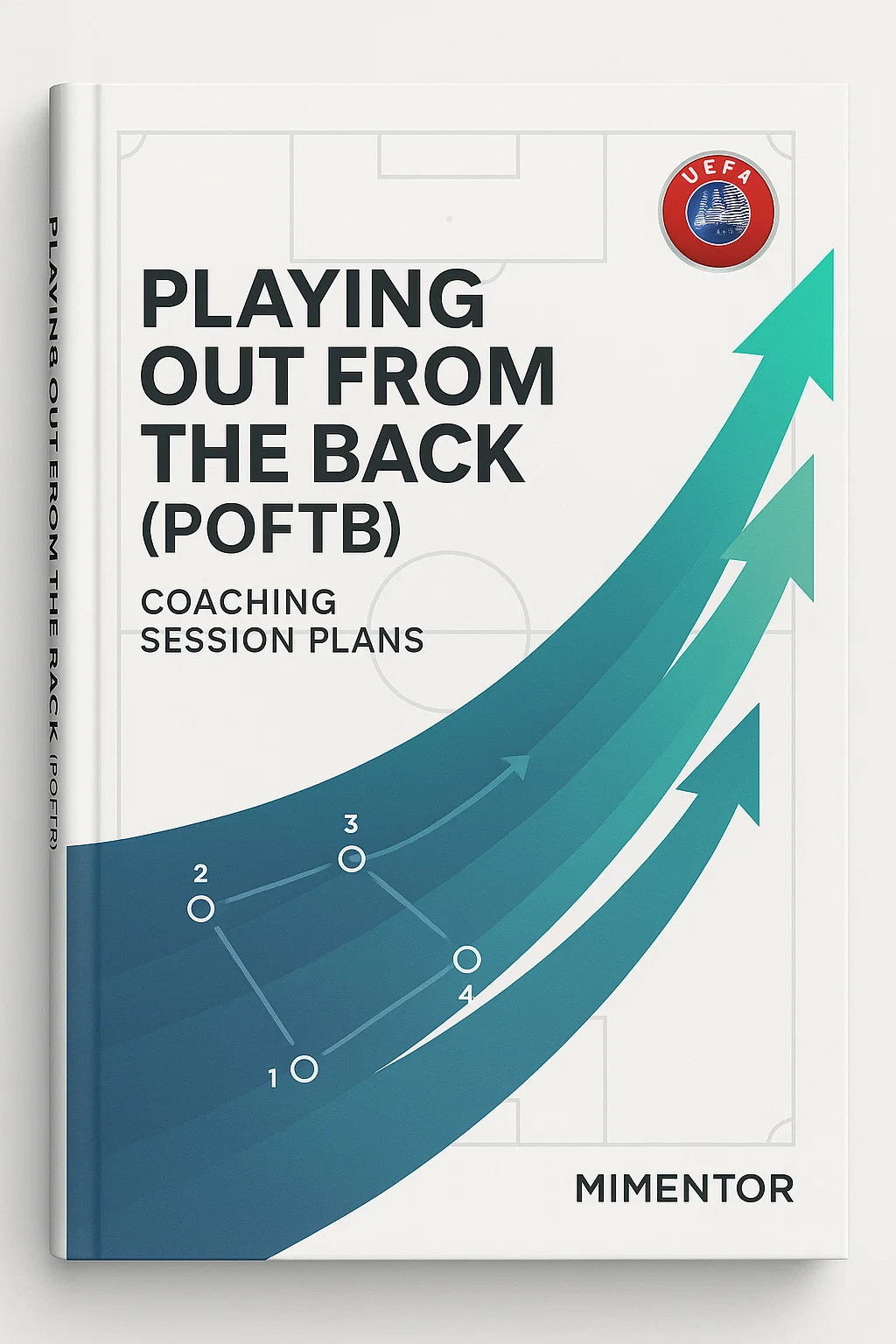
Playing Out From The Back (POFTB): COACHING SESSION PLANS
Introduction: The Modern Imperative
Playing Out From The Back (POFTB) has evolved from a risky tactic into a fundamental principle of modern football. It is a philosophy of control, aimed at drawing the opposition in to exploit space and build attacks through structured possession. This guide provides a streamlined blueprint for coaches to develop effective POFTB session plans, moving from theory to practice.
For a foundational understanding of advanced coaching principles, the UEFA A Licence: The Complete Coach’s Guide PDF is an essential resource.
Core Principles: The Three Pillars of POFTB
1. Structural Organization
The foundation of POFTB is a clear, well-drilled shape. The goalkeeper acts as an outfield player, defenders provide width, and midfielders offer support in the half-spaces to create passing angles. This structure is designed to create numerical overloads against the first line of the press.
The philosophy of managers like Pep Guardiola, who mastered this approach, is detailed in resources like The Coaches’ Voice which analyses elite tactical setups.
2. Technical Proficiency
Without technical skill, structure is irrelevant. Players must master crisp passing under pressure, a first touch that manipulates the ball away from opponents, and body orientation that allows them to play forward. This requires dedicated technical drilling.
Drills to develop these skills can be found in comprehensive collections like 60 Training Games PDF and Soccer Training Programs.
3. Tactical Intelligence
Players must constantly scan and make smart decisions: when to play short, when to switch play, and when to go long. Recognizing pressing triggers is key to breaking through an opponent’s system.
Understanding these principles in a broader context is covered in the Principles of Play: Attacking PDF.
A Progressive Three-Phase Coaching Model
Phase 1: Foundation (Low Pressure)
Objective: Develop muscle memory and basic movements.
- Session Example: A 4-station technical circuit focusing on GK-CB exchanges, CB-FB-CM triangles, and switching play. Use rondos in a positional shape to build comfort in possession.
- Resource: Start every session with integrated routines from Warm-Up Exercises with Ball PDF.
Phase 2: Application (Medium Pressure)
Objective: Apply skills in game-like scenarios.
- Session Example: 9v6 Build-Up Game. Attackers (GK + 8) aim to break through a structured press (6 defenders) and progress into the final third. Coach decision-making and passing angles.
- Resource: For session ideas, see UEFA B License Coaching Sessions PDF.
Phase 3: Integration (High Pressure)
Objective: Test the strategy in a full, game-realistic environment.
- Session Example: Conditioned 11v11. A condition where a goal only counts if all 10 outfield players touch the ball in the buildup, encouraging sustained possession from the back.
- System-Specific Training: For teams using a back three, specific patterns are required. The Essential 3-5-2 and 3-4-3 Training Exercises PDF is invaluable.
Learning from the Best: Academy Case Studies
Implementing POFTB successfully is exemplified by top academies. For instance, the approach at Sheffield United F.C. U14 Academy focuses on building these principles from a young age. Similarly, the Leicester City Football Club Academy PDF highlights how a clear playing philosophy is instilled throughout all age groups.
For a deep dive into the philosophy that inspired many, explore Marcelo Bielsa’s Football Philosophy PDF.
Conclusion: Building Your Philosophy of Play
In conclusion, coaching Playing Out From The Back is not about blindly copying trends; it is about intentionally building a philosophy of possession, control, and proactive football. The journey requires patience, consistent repetition of key principles, and a progressive training model that moves players from understanding to execution under pressure.
The session plans outlined here provide a roadmap. Begin by cementing the technical and structural foundations, then gradually layer on pressure through opposed practices and phase-of-play exercises, before finally testing the strategy in conditioned games. Remember, the ultimate goal is to develop intelligent players who can read the game and make the right decisions autonomously.
To continue your development as a coach, consider furthering your education through official pathways like those detailed in the UEFA Pro License Course PDF or the AFC B Diploma Coaching Course Certificate PDF. For daily insights and analysis on how the top teams implement these ideas, follow experts on Twitter and read articles on The Athletic.
Ultimately, your coaching journey is about continuous learning. Use resources like the UEFA B License Coaching Manual PDF and The Training Plan to refine your craft. By committing to this process, you will not only teach your team how to play out from the back but also how to dominate the game from the first whistle.
